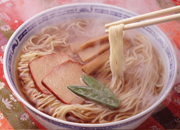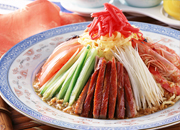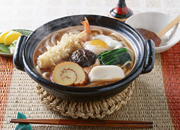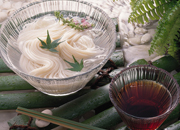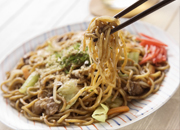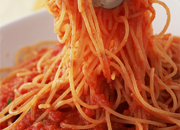Soba-A soul food of tokyo
Delicious hot or cold
Made from buckwheat flour, soba is a traditional noodle dish in Japan and is considered to represent Japanese cuisine along with sushi and tempura. Soba is served in a hot soup, or is cooled and served on a strainer along with dipping sauce. Simple cold soba menus include zarusoba (with nori seaweed topping) and morisoba (without nori topping). Soba is a very common menu Japanese people regularly eat and is available at various types of eateries, from specialty restaurants to tachigui (stand-and-eat) shop. Soba cup noodles are also popular to eat at home, as it is ready within a few minutes after pouring hot water.
Dark-colored soup in Kanto; light-colored soup in Kansai
Just like many other Japanese dishes, there are some local differences for soba noodles. In the Kanto region, a soup for soba is dark-colored and strongly flavored, as it is prepared by boiling katsuobushi (bonito flake) dashi stock with koikuchi (dark-colored) shoyu, mirin, and sugar. On the other hand, soba in the Kansai region is served in a soup whose flavor centers that of bonito/kelp dashi stock. It is seasoned and lightly colored by usukuchi (light-colored) shoyu.
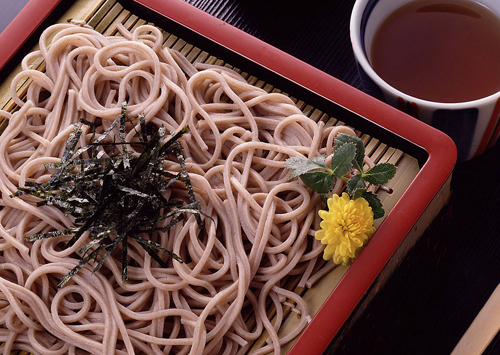
Slurping is not a bad manner
Chopped negi onion is a common condiment that accompanies both hot and cold soba noodles. To add a spice, hot soba is served with shichimi togarashi (hot pepper sprinkles) while cold soba comes with wasabi. At many soba restaurants, servers bring a pot of sobayu to the table when customers finish eating cold soba, such as morisoba or zarusoba. Sobayu is cooking water from boiling noodles and is added to a dipping sauce cup to thin down the sauce for enjoying the flavor of soba until the last drop. Although making noises while eating is generally considered a bad manner at the table, soba and udon noodles are an exception in Japan, and it has been customary to slurp up the noodles to eat. It is said that soba tastes better because a flow of air is created when slurping to bring aroma of soba to the mouth.
History of soba
Soba : A crop grown since ancient times
The history of growing soba (buckwheat) goes back to ancient times, to the Jomon period in Japan. During the Kamakura period, a grinder was introduced from China and made it easy to produce soba flour. While soba has been regularly eaten since then, the method of making soba into noodles (sobakiri), which are the most common form of soba dish today, is said to have been invented during the late 16th through early 17th centuries.
Soba as a common food in Japanese daily lives
According to records, a number of soba street stands were open at night in addition to soba restaurants during the Edo period. People of Edo were particular about how to eat soba for enjoying its natural flavor. Dipping only tips of cold soba noodles in a sauce, and swallowing rather than chewing the noodles once putting them in a mouth, are among such eating manners that were considered iki (sophisticated, stylish). Soba became an important dish in the lifestyle of people in Edo and began to be served to mark some significant events in lives of Japanese people. Hikkosi-soba was often given to neighbors when moving into a new neighborhood. Toshikoshi-soba is still commonly eaten today on the last day of the year (omisoka) to accompany one's wish for a healthy and long life.
 Kiso Kaido Rokuju-kyu-tsugi
Kiso Kaido Rokuju-kyu-tsugi
Utagawa Kunishige
1852 (Kaei 5)
Tokyo Metropolitan Library ※All rights reserved





